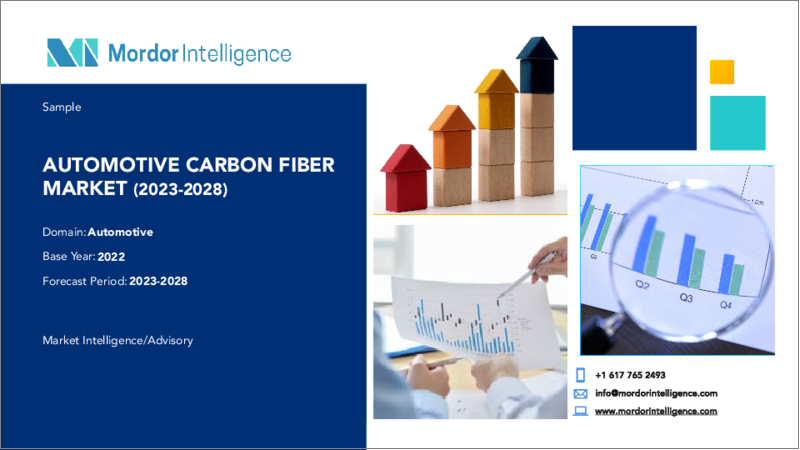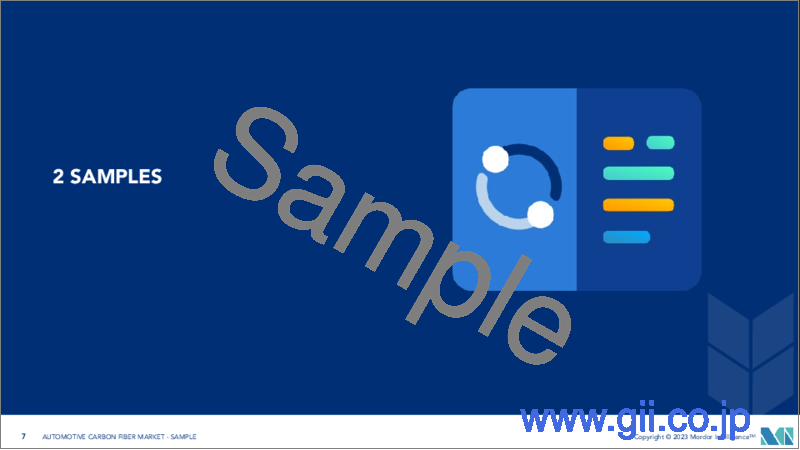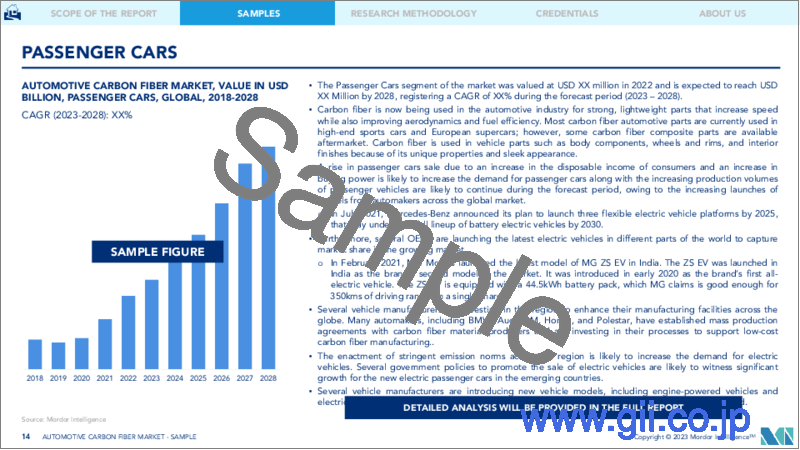|
|
市場調査レポート
商品コード
1189918
自動車用炭素繊維市場- 成長、動向、予測(2023年-2028年)Automotive Carbon Fiber Market - Growth, Trends, and Forecasts (2023 - 2028) |
||||||
|
● お客様のご希望に応じて、既存データの加工や未掲載情報(例:国別セグメント)の追加などの対応が可能です。 詳細はお問い合わせください。 |
|||||||
| 自動車用炭素繊維市場- 成長、動向、予測(2023年-2028年) |
|
出版日: 2023年01月18日
発行: Mordor Intelligence
ページ情報: 英文 100 Pages
納期: 2~3営業日
|
- 全表示
- 概要
- 目次
自動車用炭素繊維の市場規模は220億8000万米ドルで、予測期間中にCAGR 10.80%で408億5000万米ドルまで成長すると予想されています。
COVID-19の大流行により、世界の輸送、輸出入が完全に停止し、市場に深刻な影響を及ぼしました。世界の規制により、主要な製造業が工場を閉鎖し、炭素繊維市場の研究・生産に支障をきたしました。世界の炭素繊維製造業の大半が日本にあるため、自動車産業のサプライチェーンが寸断されました。
昨年は、自動車産業の処理能力を見直した結果、自動車産業が着実に成長する転換期となりました。このため、炭素繊維の需要も高まっています。
炭素繊維は、高強度特性を持つ軽量素材であり、自動車用途での性能を高めるために設計することができます。構造的、機能的、あるいは外観的な特性を向上させることができます。自動車の軽量化、クリーン化、安全性、コスト削減を実現するために、大手炭素繊維サプライヤーは、自動車OEM、システムサプライヤー、顧客のニーズと期待に応えています。BMW、アウディ、GM、ホンダ、Polestarなど多くの自動車会社は、炭素繊維材料メーカーと大量生産に関する契約を締結し、低コストの炭素繊維製造をサポートするためのプロセスへの投資を進めています。
厳しい排ガス規制の高まりと燃料価格の上昇により、従来の金属に代わる優れた素材である炭素繊維は、車両の重量を減らすことができます。これは、燃料効率とエンジンの性能を向上させることができる一方で、繊維の物理的強度の限界は従来の金属のほぼ2倍に達します。世界中で電気自動車の需要が高まっていることから、電気自動車の航続距離を伸ばすために炭素繊維の普及が進むと思われます。
主なハイライト
- Ferrari, Lamborghini, Koenigsegg, Paganiなど、自動車の製造に炭素繊維を多用する自動車メーカーが多いことから、欧州が市場のリーダーになると予想されます。欧州に次いで、北米、アジア太平洋地域が、性能の高い自動車への需要を伸ばしています。アジア太平洋地域内では、中国と日本が2大市場となる構えです。
主な市場動向
自動車における炭素繊維の採用が進む
自動車業界では、速度を上げ、空気力学と燃費を改善するために、丈夫で軽量な部品として炭素繊維の利用が始まっています。現在、ほとんどの炭素繊維自動車部品は、高級スポーツカーや欧州のスーパーカーに使用されていますが、一部の炭素繊維複合部品はアフターマーケットで販売されています。ボディ部品、ホイールやリム、内装仕上げなどの自動車部品は、そのユニークな特性と洗練された外観のために炭素繊維を利用しています。
炭素繊維のような先端材料は、性能と安全性を維持するために、現代の自動車の燃費を向上させるために不可欠です。重い物体よりも軽い物体を加速させる方がより少ないエネルギーで済むため、軽量素材は自動車の効率と燃費を向上させる大きな可能性を秘めています。車両の重量を10%減らすと、燃費が6~8%向上します。
大手企業は、自動車の効率を高めるために炭素繊維コンポーネントの研究開発に投資しています。例えば、以下のようなものです。
- 2022年11月、超高級電気自動車ブランドの Aheraは、SUVの第1号モデルの外観デザインを公開しました。この車両は、鍛造炭素繊維を含む持続可能性の高い複合材料で構成されています。
- 2022年10月、Nissan Motorsは、5.6リッターV型8気筒エンジンを搭載し、カーボンファイバーのフロントフェンダーとベッドサイド、カーボンボンネットを備えたワイドボディキットと一体化したピックアップトラック「Frontier」を公開しました。
- 2022年5月、Hexcelは、バイオ由来の樹脂成分で作られたヘクセル樹脂システムと天然繊維強化材を組み合わせ、自動車、ウィンタースポーツ、海洋、風力エネルギー用途の材料ソリューションを生み出す新しい製品群を開発しました。
BMWは、7シリーズセダンのルーフや支柱などの上部にカーボンファイバー部品を使用し、車の低重心化を図っています。一方、アルファロメオ4Cは、完全なカーボンファイバー製シャーシを採用し、車両重量をわずか2,500ポンドに抑えています。同じようなスタイルやサイズの他の車は一般的に3,000ポンド以上あるので、4Cはこのクラスでは軽量な高級車と言えます。BMWと炭素繊維の生産パートナーであるSGLグループは、i3とi8に使用されるCFRPのサプライチェーン確立のために約10億米ドルを費やしました。AudiもA8セダンのスペースフレームのリアウォールを炭素繊維で製造しています。供給側でも、炭素繊維メーカーが生産能力を増強しており、自動車への炭素繊維の採用がさらに進むと思われます。
こうした要因や動向を考慮すると、高効率の炭素繊維の需要は予測期間中に高い可能性を持つと予想されます。
市場を独占しているのは欧州
高級車とスポーツカー市場は、炭素繊維の使用に関して高い可能性を持っていると予想されます。欧州は、高級車とスポーツカーの旺盛な需要を描く主要地域であると予想されます。
欧州の高級車市場は、SUVが牽引すると予想されます。従来の乗用車は市場での地位を失いつつあります。これは米国で始まった世界の動向で、その後、欧州やアジアにも波及しています。欧州でSUVがベストセラーになっているブランドには、Nissan, Hyundai, Kia, Mazda, Mitsubishi, Jaguar, Lexus, Porsche, Maserati, and Volvoなどがあります。これらの車両の売上高は、長期的には自動車用エアサスペンションの需要を駆動するでしょう。
英国の自動車産業は、現在、 Aston Martin, Bentley, Daimler, Jaguar, Lagonda, Land Rover, Lotus, McLaren, MG, Mini, Morgan, and Rolls-Royceといったプレミアムカーやスポーツカーメーカーでよく知られています。同国の乗用車販売台数は、2021年の163万1064台から164万7181台と1.0%増加しました。この成長の背景には、これらのOEMメーカーが先進のボディ素材を組み込んだ最新モデルを発売したことがあります。
欧州地域で厳しい排ガス規制と燃費基準が制定されたことを受け、ドイツ、イタリア、フランスの自動車メーカー(BMW、Volkswagen、Audiなど)は、自動車の製造に炭素繊維複合材を使用するようになりました。
各社は、自動車の総重量を大幅に削減できる炭素繊維製の新しい部品を発明しようとしています。炭素繊維強化プラスチック(CFRP)の用途は、特にフェラーリ、ランボルギーニ、ポルシェなどのハイパーカーメーカーの自動車ボディの製造に広く採用されています。
これらの要因を考慮すると、自動車部品用の炭素繊維の需要は、高級車やスポーツカーの販売により、欧州地域で高い成長率を描くと予想されます。
競合情勢
自動車用炭素繊維市場は統合された市場です。トップ企業10社が市場シェアの大半を占めています。炭素繊維市場の主要企業には、Hexcel Corporation、Mitsubishi Chemical Carbon Fiber and Composites Inc.、SGL Carbon SE、Teijin Limited、Toray Industries Inc.が含まれます。
炭素繊維メーカーが採用する強力な拡張・成長戦略に起因して、需要はプラスサイドにあります。例えば、2021年3月、Teijin LimitedとApplied Electric Vehicle(Applied EV)は、将来のモビリティ用途に向けたポリカーボネート製ソーラールーフを共同開発しました。
その他の特典
- エクセル形式の市場予測(ME)シート
- アナリストサポート3ヶ月分
目次
第1章 イントロダクション
- 調査の前提条件
- 調査範囲
第2章 調査手法
第3章 エグゼクティブサマリー
第4章 市場力学
- 市場促進要因
- 市場抑制要因
- 産業の魅力- ポーターのファイブフォース分析
- 供給企業の交渉力
- 買い手/消費者の交渉力
- 新規参入業者の脅威
- 競争企業間の敵対関係
- 代替品の脅威
第5章 市場セグメンテーション(市場規模:10億米ドル単位)
- 用途
- 構造部品
- パワートレイン部品
- 内装
- 外装
- 車種
- 乗用車
- 商用車
- 地域
- 北米
- 米国
- カナダ
- その他北米地域
- 欧州
- ドイツ
- 英国
- フランス
- その他の欧州地域
- アジア太平洋地域
- 中国
- 日本
- インド
- 韓国
- その他アジア太平洋地域
- 世界のその他の地域
- ブラジル
- アルゼンチン
- その他の南米地域
- 北米
第6章 競合情勢
- ベンダーの市場シェア
- 企業プロファイル
- Toray Industries
- Hexcel Corporation
- Mitsubishi Chemical Carbon Fiber and Composites Inc.
- SGL Carbon SE
- Solvay
- Teijin Ltd
- DowAksa USA LLC
- A&P Technology Inc.
- Zoltek Corp.
- Toho Tenax Europe GmbH
第7章 市場機会と今後の動向
The automotive carbon fiber market is valued at USD 22.08 billion, and it is expected to grow up to USD 40.85 billion with a CAGR of 10.80% during the forecast period.
The COVID-19 pandemic severely impacted the market owing to the complete standstill of global transport, imports, and exports. Major manufacturing industries shut down their plant due to restrictions worldwide, and the research and production that goes into the carbon fiber market were hindered. With the majority of the world's carbon fiber production industries located in Japan, the supply chain for the automotive industry was disrupted.
The last year remained the year for transition, where the automotive sector witnessed steady growth after revamping the automotive industry throughput. This has also elevated the demand for carbon fiber.
Carbon fiber is a lightweight material with high-strength characteristics that can be designed for enhanced performance in automotive applications. It offers improvement in structural, functional, or cosmetic properties. To make vehicles lighter, cleaner, safer, and more cost-effective, the leading carbon fiber suppliers are responding to the needs and expectations of vehicle OEMs, system suppliers, and customers. Many car companies, such as BMW, Audi, GM, Honda, and Polestar, have established agreements with carbon fiber material producers for mass production and are investing in their processes to support low-cost carbon fiber manufacturing.
Growing stringent emission norms and rising fuel prices, carbon fiber, a great alternative to conventional metals, can reduce the vehicle's weight. This can improve the fuel efficiency and performance of the engine while the fiber's physical strength limits are almost twice as high as those of conventional metals. The rise in demand for electric vehicles across the world is likely to increase the penetration of carbon fiber to enhance the range of electric vehicles.
Key Highlights
- Europe is expected to be the market leader due to the presence of many car manufacturers, such as Ferrari, Lamborghini, Koenigsegg, Pagani, etc., who use a lot of carbon fiber in manufacturing their cars. Europe is closely followed by North America and Asia-Pacific, with growing demand for performance vehicles. Within the Asia-Pacific, China and Japan are poised to be the two largest markets.
Key Market Trends
Increasing Adoption of Carbon Fiber in Automobiles
The automotive industry has started using carbon fiber for strong, lightweight parts that increase speed and improve aerodynamics and fuel efficiency. Currently, most carbon fiber automotive parts are used in high-end sports cars and European supercars; however, some carbon fiber composite parts are available in the aftermarket. Vehicle parts such as body components, wheels and rims, and interior finishes utilize carbon fiber for their unique properties and sleek appearance.
Advanced materials such as carbon fiber are essential for boosting the fuel economy of modern cars for maintaining performance and safety. Since it takes lesser energy to accelerate a lighter object than a heavier one, lightweight materials offer great potential for increasing vehicle efficiency and fuel economy. A 10% reduction in the vehicle's weight can transpire to a 6-8% increase in fuel economy.
Major players are investing in the research and development of carbon fiber components to enhance vehicle efficiency. For instance,
- In November 2022, Ahera, an ultra-premium electric automotive brand, revealed the exterior design of the first model of its SUV. The vehicle is made up of highly sustainable composite material, including forged carbon fiber.
- In October 2022, Nissan Motors showcased its Frontier pickup truck powered by a 5.6-liter V-8 engine and integrated with a wide-body kit featuring carbon-fiber front fenders and bedsides, along with a carbon hood.
- In May 2022, Hexcel developed a new product range that combines Hexcel resin systems made with bio-derived resin content with natural fiber reinforcements to create material solutions for Automotive, Winter Sports, Marine, and Wind Energy applications.
BMW uses carbon fiber components in the upper portions of its 7-series Sedan, such as roof elements and supporting pillars, with the intention of lowering the car's center of gravity. The Alfa Romeo 4C, on the other hand, has a complete carbon fiber chassis, which cuts the weight of the vehicle down to just 2,500 lbs. Other cars of similar styles and sizes generally weigh 3,000 lbs or more, making the 4C a lightweight luxury in its class. BMW and its carbon fiber producing partner, the SGL Group, spent close to USD 1 billion for establishing the supply chain for the CFRP used in the i3 and i8. Audi is also using carbon fiber to produce the rear wall of the space frame for its A8 sedan. Even from the supply side, carbon fiber manufacturers have been ramping up their production capacities, which will further help in the adoption of carbon fiber in automobiles.
Considering these aforementioned factors and developments, the demand for highly efficient carbon fiber is anticipated to hold high potential during the forecast period.
Europe is Dominating the Market
The luxury car and sports car market is anticipated to hold high potential for the usage of carbon fiber. Europe anticipates itself as the leading region to portray strong demand for luxury cars and sports cars.
The European luxury car market is expected to be driven by SUVs. Traditional passenger cars are losing their hold in the market. It is a global trend that started in the US and then spread to Europe and Asia. Some of the brands whose best-seller SUVs are in Europe include Nissan, Hyundai, Kia, Mazda, Mitsubishi, Jaguar, Lexus, Porsche, Maserati, and Volvo. These vehicle sales would drive the demand for automotive air suspension in the long run.
The automotive industry in United Kingdom is now best known for premium and sports car manufacturers, including Aston Martin, Bentley, Daimler, Jaguar, Lagonda, Land Rover, Lotus, McLaren, MG, Mini, Morgan, and Rolls-Royce. The country's passenger car sales increased from 1,631,064 units in 2021 to 1,647,181 units, an increase of 1.0%. This growth is backed by the launch of the latest models by these OEMs embedding the advanced body material in the vehicle.
With the enactment of stringent emission norms and fuel economy standards in the European region, automobile manufacturers in Germany, Italy, and France, such as BMW, Volkswagen, Audi, etc., have started using carbon fiber composites in manufacturing their vehicles.
Companies are trying to invent new parts made of carbon fiber that can reduce a vehicle's total weight to a great extent. The application of carbon-fiber-reinforced plastic (CFRP) has been widely adopted for the production of automotive bodies, particularly in hyper-car manufacturers such as Ferrari, Lamborghini, and Porsche.
Considering these factors, the demand for carbon fiber for automotive parts is anticipated to portray a high growth rate in the European region due to luxury and sports car sales.
Competitive Landscape
The automotive carbon fiber market is a consolidated market. The top 10 players account for most of the market share. Major companies in the carbon fiber market include Hexcel Corporation, Mitsubishi Chemical Carbon Fiber and Composites Inc., SGL Carbon SE, Teijin Limited, and Toray Industries Inc.
The demand is on the positive side, attributed to strong expansion and growth strategies adopted by the carbon fiber manufacturers. For instance, in March 2021, Teijin Limited and Applied Electric Vehicle (Applied EV) jointly developed a polycarbonate solar roof for future mobility applications.
Additional Benefits:
- The market estimate (ME) sheet in Excel format
- 3 months of analyst support
TABLE OF CONTENTS
1 INTRODUCTION
- 1.1 Study Assumptions
- 1.2 Scope of the Study
2 RESEARCH METHODOLOGY
3 EXECUTIVE SUMMARY
4 MARKET DYNAMICS
- 4.1 Market Drivers
- 4.2 Market Restraints
- 4.3 Industry Attractiveness - Porter's Five Forces Analysis
- 4.3.1 Bargaining Power of Suppliers
- 4.3.2 Bargaining Power of Buyers/Consumers
- 4.3.3 Threat of New Entrants
- 4.3.4 Intensity of Competitive Rivalry
- 4.3.5 Threat of Substitute Products
5 MARKET SEGMENTATION (Market Size in Valued USD Billion)
- 5.1 Application
- 5.1.1 Structural Assembly
- 5.1.2 Powertrain Components
- 5.1.3 Interiors
- 5.1.4 Exteriors
- 5.2 Vehicle Type
- 5.2.1 Passenger Car
- 5.2.2 Commercial Vehicle
- 5.3 Geography
- 5.3.1 North America
- 5.3.1.1 United States
- 5.3.1.2 Canada
- 5.3.1.3 Rest of North America
- 5.3.2 Europe
- 5.3.2.1 Germany
- 5.3.2.2 United Kingdom
- 5.3.2.3 France
- 5.3.2.4 Rest of Europe
- 5.3.3 Asia-Pacific
- 5.3.3.1 China
- 5.3.3.2 Japan
- 5.3.3.3 India
- 5.3.3.4 South Korea
- 5.3.3.5 Rest of Asia-Pacific
- 5.3.4 Rest of the World
- 5.3.4.1 Brazil
- 5.3.4.2 Argentina
- 5.3.4.3 Rest of South America
- 5.3.1 North America
6 COMPETITIVE LANDSCAPE
- 6.1 Vendor Market Share
- 6.2 Company Profiles*
- 6.2.1 Toray Industries
- 6.2.2 Hexcel Corporation
- 6.2.3 Mitsubishi Chemical Carbon Fiber and Composites Inc.
- 6.2.4 SGL Carbon SE
- 6.2.5 Solvay
- 6.2.6 Teijin Ltd
- 6.2.7 DowAksa USA LLC
- 6.2.8 A&P Technology Inc.
- 6.2.9 Zoltek Corp.
- 6.2.10 Toho Tenax Europe GmbH




